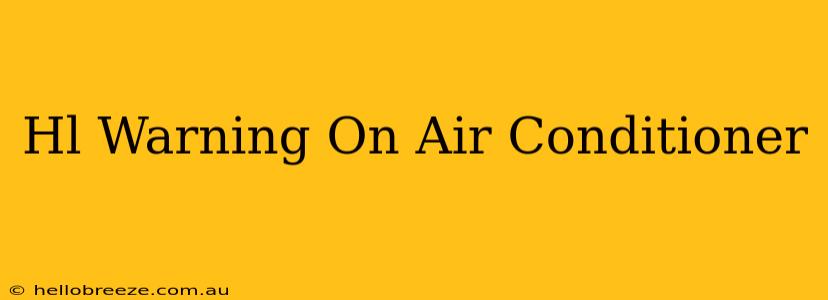Air conditioners are essential for comfort, especially during hot weather. However, encountering an "HL" warning on your unit can be alarming. This comprehensive guide will help you understand what the HL error code signifies, potential causes, and importantly, how to ensure your safety.
Decoding the HL Warning Code
The "HL" warning code on an air conditioner isn't a standardized code across all brands. Different manufacturers may use "HL" to indicate various problems. It's crucial to consult your air conditioner's user manual to understand the specific meaning for your model. Generally, however, "HL" often points to problems with the high-pressure switch or related components within the refrigerant system. This is a critical safety concern because high pressure in the system can lead to serious damage or even injury.
Potential Causes of the HL Error Code
While the exact cause will vary depending on your AC unit, some common culprits behind the "HL" error code include:
-
Refrigerant Leaks: Low refrigerant levels can cause the system to operate under high pressure, triggering the HL warning. Leaks can develop in various parts of the system, requiring professional detection and repair.
-
Clogged Filters or Coils: Dirty air filters and clogged condenser coils restrict airflow, leading to increased pressure within the system. Regularly cleaning or replacing these components is crucial for optimal performance and to prevent errors like "HL".
-
Faulty Compressor: A malfunctioning compressor can cause high pressure build-up. This is a significant problem requiring professional repair or replacement.
-
Blocked Airflow: Obstacles around the outdoor unit, such as overgrown vegetation or debris, can impede airflow and lead to increased pressure. Ensuring clear airflow around the unit is essential for preventing the HL error.
-
Problems with the High-Pressure Switch Itself: In some instances, the high-pressure switch may malfunction, triggering the alarm even if there's no actual high-pressure issue.
What to Do When You See the "HL" Warning
Do not attempt to repair the air conditioner yourself. Working with refrigerant systems requires specialized knowledge and equipment, and improper handling can be dangerous.
-
Consult your user manual: Your manual should provide specific instructions and troubleshooting steps for the "HL" error code on your model.
-
Turn off the unit: Immediately switch off your air conditioner to prevent further damage and potential safety hazards.
-
Check for Obvious Obstructions: Inspect the outdoor unit for any blockages that may be restricting airflow. Clear away any debris, leaves, or overgrown vegetation.
-
Contact a Qualified Technician: Schedule a service appointment with a qualified HVAC technician. They have the necessary expertise, tools, and safety equipment to diagnose and repair the issue.
Preventing Future HL Errors
Preventive maintenance is key to avoiding costly repairs and ensuring your air conditioner's longevity. Regular maintenance should include:
-
Cleaning or Replacing Air Filters: Change or clean your air filters regularly, as recommended by the manufacturer.
-
Inspecting and Cleaning Coils: Schedule professional coil cleaning at least once a year, or more often if necessary.
-
Annual Professional Inspections: Regular inspections by a qualified technician can identify potential problems before they escalate into major issues, like triggering an "HL" warning.
Ignoring an "HL" warning can lead to serious problems, including compressor damage, refrigerant leaks (which damage the environment and your equipment), and potential safety hazards. Prioritize prompt action to ensure your comfort and safety.

